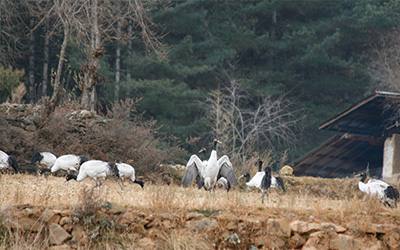Entry: Paro
Exit: Paro
Duration: 6 Days
Districts: Paro, Thimphu, Wangduephodrang
Summary
Black-necked Cranes (Grus nigricollis) fly into Bhutan from late October to mid February. This endangered birds roost at Phobjikha valley in large numbers, which has been declared a protected area for the crane.
On arrival in Phobhjikha (also called the ‘Gangtey Valley’) they circle the Gangtey Monastery (also known as Gangtey Gonpa) three times, in what people believe is an act of paying obeisance to the gods of the monastery. The same is repeated when they fly back from Phobjikha.
Itinerary
Day 01 – Bangkok/ Delhi/ Katmandu – Paro – Thimphu
You will land at Paro international Airport, after having experienced one of the most thrilling journeys of your lifetime – the flight to Paro, during which you experience a breath taking view of Mount Everest, Kanchenjunga and other famous Himalayan peaks, including the sacred Jomolhari and Mount Jichu Drake. The landing at Paro, considered one of the most challenging is an enthralling experience.
At the airport, you will be received by our company’s representatives and driven to Thimphu, where you halt for the night.
Day 02: Excursion Thimphu
Thimphu has lots to offer and the pick for you will firstly be the Memorial Chorten, one of Bhutan’s most beautiful stupas, built in memory of the Third King, Late His Majesty Jigmi Dorji Wangchuck, known as the Father of Modern Bhutan. A short drive from there will take you to Buddha Point, where the statue of the World’s largest Future Buddha (Maitreya) will be seen.
From there we will move to the Handicraft’s Emporium, Weaving Centre and Changangkha monastery, one built in the 12th century. There will also be visits to the Takin zoo, Sangaygang, which offers a view point of Thimphu valley and a Nunnery.
Lunch will be served at a local restaurant, after which we visit the National Library where ancient manuscripts are preserved and the Wood Craft and Painting school.
In the evening, we will visit Tashichho Dzong, the main secretariat building. This massive structure houses part of the government Ministries, the office of the King and the Throne Room. It also houses the State Monastic Body and the living quarters of the Chief Abbot and the senior monks.
Overnight in hotel.
Day 03: Thimphu – Gangtey
After breakfast, drive to Phobjikha (127 km). During this journey you will pass Dochula pass (3,100 m). From here one can see the Himalayan range of snow clapped mountains if the day is clear. Lunch will be served at Wangduephodrang. After lunch, we continue the journey to Phobjikha.
Phobjikha is a wide alpine wetland valley that is considered the largest and the most significant wetland in the country. It is often cited for the harmonious co‐existence of its inhabitants with nature and the valley also holds great cultural significance. The valley is the most significant wintering ground of the rare and endangered Black‐necked cranes in Bhutan and has been protected since time immemorial by the local people’s traditional respect for all living beings. Every year, over 300 of the estimated 500 cranes that migrate to Bhutan spend their winter months in this valley. Additionally, the highly revered Gangtey Monastery that overlooks the wetlands surrounded by subsistence farms and natural forest areas makes Phobjikha a stunningly beautiful and sacred valley. Today, this glacial valley is an attraction not just to tourists but also pilgrims.
Overnight in camp, Alt. 3,900 m.
Day 04: Gangtey – Paro
Early morning visit the site of the black necked cranes and Gangtey Goempa. After early lunch drive back to Paro.
Overnight in hotel.
Day 05: Paro Sightseeing
After breakfast drive along the winding road northwest up the Pa Chu to Drugyel Dzong, the ruined Fort (destroyed by fire in 1950.) which once defended this valley from the Tibetan invasion. From here one can have the view of sacred Mt. Jomolhari on clear days. On the way back stop for a view of Taktsang (tiger’s nest) Monastery which clings on the sheer drop of rock face where the saint Guru Padma-sambhava landed on a flying tigress and mediated there. After lunch, drive to Ta Dzong, formerly a Watch Tower which now houses the National Museum. After a short stroll in town drive back to hotel for the night halt.
Day 06: Departure from Paro – After an early breakfast, you will be driven to the airport for your departure from the country.
Black-necked Crane Festival
The Annual Black-necked Crane festival is celebrated in the courtyard of Gangtey Gonpa, in Phobjikha valley. The festival is an occasion for the locals to rejoice and celebrate the arrival of this endangered and majestic bird which becomes an inseparable part their daily lives during the winter months.
It is organized to generate awareness and understanding on the importance of conserving the cranes; to strengthen the linkages between conservation, economic welfare and sustainable livelihoods of the community; provide an avenue for the local community to renew their commitment to conservation of the black-necked cranes, and to showcase their cultural heritage and skills.
The festival includes cultural programs such as folk songs and dances (some with black-necked crane themes) and mask dances performed by the local people, crane dances and environmental conservation-themed dramas and songs by the school children. The festival is organized by the Phobjikha Environment Management Committee (PEMC), a local group composed of elected local leaders (with a strong female component), Government representatives, business community representatives, monks and Royal Society for the Protection of Nature (RSPN) representative.
